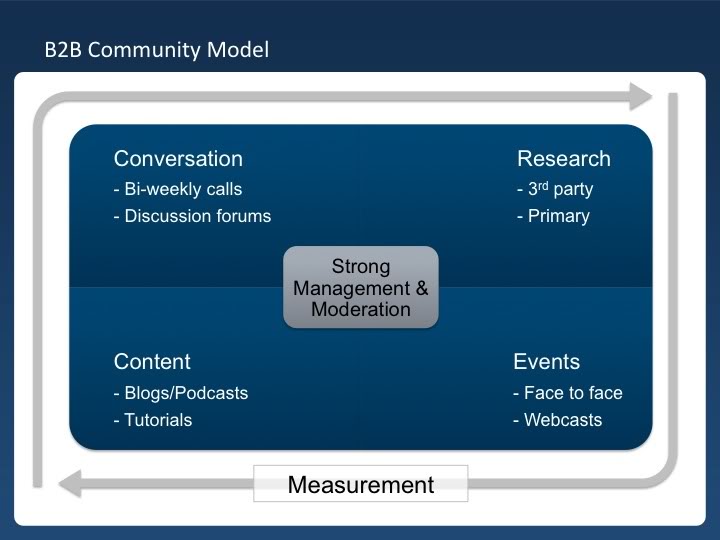This week, Return On Now has the privilege of sharing with you a guest post by Aaron Strout, CMO of Powered Inc. right here in Austin, TX. In addition to running marketing, he also serves as a key “social voice” for the company. In that capacity, Aaron continues with his speaking, blogging, podcasting, and social networking activities with an eye toward creating awareness and lead generation for the company. Aaron co-hosts the Quick-n-Dirty weekly podcast with Jennifer Leggio, he maintains a social media blog titled Citizen Marketer 2.1, and he is well-known as a thought leader in online and social media marketing.
For today’s post, Aaron has agreed to give his overview on B2B and how social media can actually be used to benefit the business. With all of the discussion surrounding concerns about measuring impact to the bottom line, I felt that this would be an important topic for all to hear.
__________________________
Why is it that, when it comes to conversation about social media, business-to-business (B2B) seems to get the short end of the stick every single time? As someone who does a lot of webcasts, blog posts, and speaking gigs, the question/comment that always comes up is, “what about B2B examples.” Fortunately for me, I’m able to mention companies like BreakingPoint Systems and Hubspot that do a great job tapping into the power of social media, but I often wish there were more examples (with public results) that I could discuss.
In thinking about this topic, one of the main reasons that B2B has taken a little longer to adopt social media into its marketing mix is that it’s harder to do effectively. It’s also feels risky because there is less control then in other channels. With that said, I personally believe that B2B companies stand to benefit the most from social media because they live and die based on the strength of their customer relationships. On top of that, many B2B companies actually know exactly who their prospective customers are, so seeking those folks out in a meaningful way and creating relationships with them can have a huge impact on the bottom line.
Given that I’m a prescriptive kind of guy, I’d feel remiss if I didn’t offer up some tips about how companies can start thinking about putting social media into practice. There are obviously tons of ways, but here are a few (including a diagram that provides more color commentary on item number three):
- Start listening. This is easier to do than you think. Set up a Google alert for your company’s name, your competitors’ names, and keywords for your industry. If you’re already doing this, consider hiring a “listening” service like Techrigy, Radian6, or Meltwater Buzz. This will help you find where all the relevant conversations in your space are happening.
- Create a Twitter account for your business. However, resist the urge to put up links to press releases, product specs, and links to press that are singing your business’s praises (at least out of the gate). Instead, talk about things that people in your industry care about. For instance, if you create bill payment software, talk about the needs of small-to-medium sized businesses across the financial spectrum (payroll, credit, vendor management, etc.) Link to reports and industry analysis. Point out other peoples’ blog posts and magazine articles.
- Set up a blog. Before you do this, though, make sure you have someone (ideally internal) who is willing to commit to posting at least 5-6 times/month. This can be someone on your marketing, product, or PR teams, or even better, one of your executives. Think about creating an editorial calendar to help guide your topics. Most importantly, spend time looking at other industry related blogs — in fact, you should spend at least a month doing this before you set up your own blog. Be sure to comment on those blogs (talk about the topic, not your company). This will help with getting to know the relevant “social” people in the space.
- Create an online community. Once you’ve gotten comfortable with items 1-3, start thinking about an online community. Ideally, this is for both current and prospective customers. Some businesses feel more comfortable about creating private communities where customers can talk to one another. The key in either case is to hire a great community manager and let them help you create relevant content via webinars, blog posts, and conference calls (see diagram below). A community manager will also help you draw out your customers and ensure that conversations stay relevant and productive.
- Measure, measure, measure. This is less difficult than you might imagine. This really should start with looking at your current goals — i.e. new customers, greater retention, larger share of wallet, referrals, etc. Then make sure you benchmark (i.e. look at your webstats and current KPI’s) before you launch your social efforts. Then, look at how you’re moving the bar over time. A key place to look is your web analytics, to see what kind of traffic and engagement your Twitter feed and/or blog efforts are driving. Also, it doesn’t hurt to survey customers and ask them if your efforts are impacting their loyalty to your company.

I won’t lie to you; everything I mentioned above takes effort. But it’s worth trying, especially when it’s done right, because it will yield results. One thing that I failed to mention is the importance of integrating the recommendations above with your existing marketing/channel activity. Social media doesn’t live in a vacuum, and if nobody can find the fruit of your efforts, you may as well not have exerted the time and resources.
Am I missing anything? You bet I am. But that’s where you come in. What types of social media have you tried? What’s worked? Please feel free to share in the comments section below.
Tommy Landry
Latest posts by Tommy Landry (see all)
- SEO Guide for Event Marketing Planners: Promotion Done Right - April 25, 2024
- What You Need to Balance When Doing SEO - April 23, 2024
- Why Pool Services Businesses Need Local SEO Visibility - April 16, 2024





